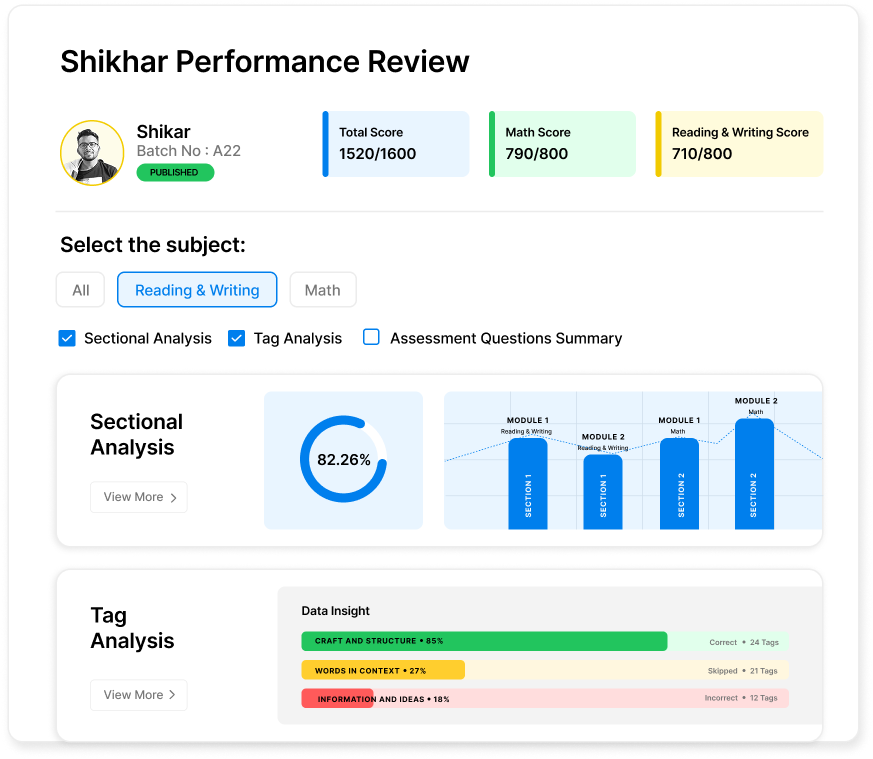




Key Takeaways
- Grammar mastery directly improves ACT English section accuracy and speed.
- Consistent practice builds confidence in spotting common ACT grammar traps.
- Focused rule review helps students write and edit with clarity and precision.
Non-native English speakers represent a growing segment of the standardized test market—with international students comprising 5.6% of total U.S. undergraduate enrollment according to the Institute of International Education's 2023 Open Doors Report.
For tutoring companies serving ESL students, the ACT vs SAT decision becomes critically important to program success. Both tests assess similar academic skills, but their formats, timing, vocabulary demands, and question styles differ in ways that can advantage or hinder someone still building fluency in English.
For test prep companies, choosing the wrong test path for ESL students means longer preparation cycles, frustrated parents, and suboptimal score improvements. This creates both retention challenges and limits your ability to demonstrate clear ROI on tutoring investments.
This guide provides tutoring professionals with a data-driven framework for ACT vs SAT recommendations for non-native English speakers. We'll analyze reading complexity metrics, vocabulary load differences, pacing pressure variations, and how language barriers interact with science and math content across both tests.
You'll discover diagnostic criteria for student assessment, individualized prep strategies for ESL learners, and how platforms like EdisonOS can streamline the decision-making process through comparative test simulations, granular progress tracking, and automated gap analysis—helping you optimize prep time and maximize score gains for your non-native English speaking students.
Key differences in language demand between the ACT and SAT for non-native English speakers
For tutoring companies developing prep strategies for non-native English speakers, understanding each test's linguistic requirements is essential for accurate student placement and efficient program design.
The SAT has historically emphasized vocabulary in context and long, evidence-based passages, whereas the ACT tends toward more direct language with shorter passages but tighter time constraints.
The SAT gives slightly more time per question in reading (≈75 sec), which helps with decoding, but the vocabulary can introduce hidden difficulty. The ACT’s questions often require faster comprehension (≈52 sec per reading question) and may feel rushed if pacing isn’t mastered, but often uses more familiar vocabulary.
For writing and grammar, both test logical clarity, but the ACT’s format presents more straightforward editing tasks, whereas the SAT’s usage questions may require a nuanced understanding of idiomatic phrasing.
Thus, non-native English speakers should pay attention to how much time is available to parse each question, whether the test format rewards careful reading (SAT) or quick recognition (ACT), and whether unknown vocabulary will block comprehension or can be inferred from context.
Running a short diagnostic on each under timed conditions reveals which language demand aligns better with a student’s current skill set.
Reading and vocabulary: format and implication
Reading comprehension represents the highest correlation with overall score improvement for non-native English speakers.
Comparative reading structure analysis
For non-native speakers, the trade-off is between time to decode (SAT) and cognitive load from unfamiliar words (SAT) versus rapid processing under pressure (ACT). Practical teaching applications should incorporate universal scanning strategies effective for both tests, including:
- Training students to identify topic sentences by locating thesis and transition statements,
- Implementing systematic key term annotation through underlining of names, dates, and concept words,
- Utilizing question pre-reading techniques where students paraphrase questions before passage analysis to focus attention, and
- Developing context clue training that builds systematic vocabulary inference techniques.
Student profile matching becomes critical for tutoring companies serving ESL populations, with distinct indicators pointing toward optimal test selection.
SAT-advantaged ESL students typically demonstrate vocabulary strength with 1200+ recognized academic words, employ deliberate reading processing styles that benefit from extended analysis time, and possess strong academic backgrounds in literature or humanities coursework.
Conversely, ACT-advantaged ESL students achieve reading speeds of 200+ words per minute in English, excel at pattern recognition with quick identification of main ideas and supporting details, and demonstrate test-taking efficiency with comfort in time-pressured environments.
Writing and grammar: strategic comparison for ESL test prep programs
The optional essay (if taken) and grammar/editing sections test language control, but in different flavours.
English learners (ELs) tend to score lower on standardized reading assessments compared to their native English-speaking peers, often due to limited vocabulary and academic language proficiency, and there is a known achievement gap in reading comprehension.
Comprehensive writing and grammar structure analysis
High-frequency grammar rules framework for ESL students
Essential mechanics for both tests include comma usage patterns with coordinating conjunctions and introductory elements, subject-verb agreement across prepositional phrases and compound subjects, pronoun clarity including antecedent agreement and case selection, and modifier placement to avoid dangling and misplaced constructions. Advanced concepts cover parallelism in series and comparisons, verb tense consistency within passages, and sentence boundary recognition for run-ons and fragments.
Tutoring companies should develop structured drilling protocols using timed sets that mimic actual test conditions, beginning with isolated grammar rule practice before progressing to passage-based applications.
Students benefit from learning error recognition patterns without overthinking, particularly for ACT English where mechanical accuracy under time pressure determines success. For SAT Writing and Language, emphasis should shift toward contextual understanding and rhetorical effectiveness, requiring deeper passage comprehension skills.
Math section and language complexity for ESL test prep
Math, on both exams, is less about complex English and more about word problems, terminology, and instructions.
Math section structure comparison
Non-native speakers should watch for:
- Multi-clause word problems where a missing phrase changes the meaning.
- Specialized terms like “consecutive,” “integer,” or “ratio” if not fully internalized.
- Instructions about units, conversions, or scenario framing that could cause avoidable errors.
Practice translating word problems into "math shorthand"—have students restate in their own words before setting up equations. Pre-teaching common mathematical vocabulary through quick recall drills builds automatic recognition of key terms that frequently appear across both test formats. Practice protocols should include systematic breakdown of multi-step word problems into component parts, helping students identify relevant information while filtering out linguistic distractors.
Science (ACT) vs evidence-based Reading (SAT) for language learners
The ACT science section is not a traditional reading test but requires interpreting charts, graphs, experimental setups, and short passages. Understanding these differences enables tutoring companies to make strategic test recommendations based on student strengths and language proficiency levels.
Section structure and language demands comparison
ACT Science often proves more accessible for non-native English speakers because success depends primarily on data literacy rather than advanced English comprehension. Students can extract answers directly from charts, graphs, and experimental setups without navigating complex prose or cultural references. The visual nature of scientific data transcends language barriers, allowing students to demonstrate analytical thinking without linguistic interference.
Conversely, SAT Evidence-Based Reading requires sophisticated textual analysis, including understanding of rhetorical devices, author's tone, implicit arguments, and cultural context—skills that typically require extensive exposure to academic English and American literary traditions.
Train students to extract the “given data” first—scan figures, note variables, and then map questions to those elements before reading full explanations to reduce language interference.
Training sequences should include variable identification exercises, trend recognition patterns, and experimental design interpretation that build confidence in data-driven reasoning. Students benefit from learning to extract given information systematically, reducing reliance on complex textual explanations that may contain unfamiliar vocabulary or sentence structures.
Timing and pacing considerations
Time management represents one of the most critical factors determining ESL student success on standardized tests. The structural timing differences between ACT and SAT create distinct strategic advantages depending on student processing speed and language proficiency levels.
- SAT gives more time per question in reading and slightly in writing, which benefits students who need to decode language slowly.
- ACT compresses time, especially in reading and science, so pacing drills are essential to build automaticity.
Timing structure analysis
Key pacing drills:
- Structured timing drills should include passage chunking exercises where students complete one ACT reading passage within 8-minute intervals, building automaticity in information processing and question response.
- Checkpoint timing protocols in math sections ensure students maintain target thresholds, such as completing every 15 questions within 15-minute intervals to stay on pace.
- Transition simulation becomes critical for test day success, as students must learn to reset mentally between sections while maintaining concentration and confidence. Practice sessions should replicate actual test flow, including brief breaks and section transitions that mirror real testing conditions.
Track pacing progress explicitly: log how many questions are completed with how much time left, and adjust strategies (skip hard items early, flag and return, or pre-empt overcorrection) based on patterns. This data enables tutoring companies to identify whether students benefit from skip-and-return strategies for difficult items, early flagging systems for time-intensive questions, or prevention of overcorrection behaviors that consume excessive time.
Score reporting, optionality, superscoring, and format flexibility
Score reporting flexibility and test format options create strategic opportunities for tutoring companies serving ESL students. Understanding how scores are reported and how tests can be combined or repeated affects decision-making.
- ACT and SAT both allow multiple attempts; many colleges superscore by taking the best section or test results, so non-native English speakers can gradually build toward their target without starting over completely.
- The SAT’s essay is currently optional and treated separately; ACT’s writing test is also optional, and neither penalizes omission of the essay in most admissions contexts.
- Format differences (digital SAT rollout vs paper and digital ACT) give students options to test in their most comfortable medium, especially if their English processing is slower under digital navigation pressure.
Score reporting and superscoring analysis
Be familiar with SAT scoring and ACT scoring chart to track both composite and subsection trends, and choose the format (paper vs digital) that reduces extraneous cognitive load during the real exam.
Both tests offer optional essay components that operate independently of core scoring, allowing ESL students to focus preparation resources on sections with highest impact for college admissions. The SAT essay (currently optional) and ACT writing test neither penalize omission nor significantly influence admission decisions at most institutions, enabling tutoring programs to prioritize core academic content over extended writing assessments.
Run both official practice diagnostics under timed conditions, compare projected scores, and choose the test where the gap between effort and output is smallest.
Format flexibility considerations
Digital format adoption varies between tests, with the SAT transitioning to fully digital administration while the ACT maintains both paper and digital options. For ESL students whose English processing slows under digital navigation pressure, format selection becomes strategically important. Paper-based testing eliminates technological barriers and allows traditional annotation methods, while digital formats may offer adaptive questioning and immediate score reporting benefits.
Strategic implementation for tutoring programs
Multi-attempt planning should leverage superscoring opportunities by targeting specific section improvements across test dates rather than comprehensive score increases. ESL students can focus intensively on math sections in early attempts while building English/reading proficiency for later test dates, creating manageable preparation cycles that demonstrate consistent progress.
Score tracking protocols should monitor both composite trends and individual section performance using official scoring charts to identify optimization opportunities. Tutoring companies benefit from maintaining detailed score progression records that demonstrate program effectiveness and guide strategic test date selection.
How to choose based on individual profile
No single test is universally best; the right choice depends on a student’s English level, cognitive strengths, and test-taking style. Tutoring companies should develop structured assessment protocols that move beyond general recommendations to data-driven test matching.
Consider:
- If decoding unfamiliar vocabulary slowly is a concern, the SAT’s extra seconds per question may help, despite occasional opaque wording.
- If quick pattern recognition and direct questioning feel more comfortable, and the student can train pacing, the ACT often yields faster throughput with less inference.
- If a student’s strength is interpreting data over narrative nuance, the ACT’s science section may be a confidence booster.
- If a student improves gradually with targeted grammar drills and prefers a longer time to think through reading passages, the SAT might give more breathing room.
ESL student profile framework
Tutoring companies should evaluate vocabulary processing speed by measuring time required for unfamiliar word comprehension and context clue utilization. Students who consistently need additional seconds for vocabulary interpretation typically benefit from SAT's extended time allocation, while those who process familiar vocabulary automatically may thrive under ACT's compressed timing.
Cognitive strength assessment should distinguish between students who excel at pattern recognition and direct questioning versus those who demonstrate superior analytical thinking with inferential reasoning. Quick processors often prefer ACT's straightforward question formats, while deep thinkers may leverage SAT's complex analytical requirements.
Content preference evaluation becomes critical when comparing narrative analysis capabilities against data interpretation skills. Students who struggle with literary nuance but excel at chart analysis typically perform better on ACT science sections, while those comfortable with textual inference may prefer SAT's evidence-based reading approach.
Initial diagnostic testing should include timed sections from both test formats to measure actual performance rather than perceived preferences. Students often misjudge their optimal test choice without concrete timing and accuracy data under realistic conditions.
Preparation strategies for non-native English speakers
Focused preparation bridges language gaps and builds test-specific fluency. Tutoring companies should implement structured protocols that address both linguistic development and standardized test mechanics simultaneously.
- Build vocabulary in context: Prioritize high-frequency academic words and idiomatic phrases through reading short articles, then practice using them in sample questions so students infer meaning rather than memorize lists.
- Practice active reading: Teach students to annotate passages with purpose—circle topic sentences, underline contrast words, and summarize paragraphs in margins to reduce comprehension burden.
- Drill grammar and editing rules with example-based mini-quizzes that mirror SAT/ACT question formats, using spaced repetition to cement patterns.
- Simulate the test interface: Practice under real format conditions (timers, question navigation, on-screen tools) to reduce decision fatigue on exam day.
- Target pacing early: Use section-specific time goals and review drills to create a rhythm; for example, have the student complete an ACT reading passage in 8 minutes, review speed vs comprehension, and adjust.
- Incorporate bilingual support during prep sessions if possible: Explain tricky phrasing in the student’s stronger language first, then transition fully to English to build internalized understanding.
- Use score goals and frequent mini-assessments: Set incremental targets (e.g., improve reading from 24 to 26 in 3 weeks) and review progress weekly to keep motivation aligned.
- Leverage feedback loops: Error logs, quick debriefs after practice, and comparing explanations help non-native learners internalize correct reasoning faster.
Assessment and feedback systems
How EdisonOS helps non-native English speakers decide and prepare
EdisonOS centralizes diagnostics, compares test-style performance, and closes language-practice gaps with targeted features
- Split diagnostics
Assign both ACT-style and SAT-style practice to see real performance differences in reading, grammar, and pacing without manual setup.
- Language-specific drills
Convert weak skills (e.g., inference in reading or comma usage in English) into customized homework that reinforces patterns in bite-sized increments.
- Real-test simulation
Mirror both tests’ timing, navigation, and question formats so students build familiarity and reduce anxiety on test day.

- Progress visualization
Show students and parents side-by-side trends on SAT vs ACT performance, making the decision empirical rather than speculative.

- Goal tracking
Set score targets for each test and let EdisonOS surface which one is converging faster, including projected timelines based on current improvement rates.
- Automated feedback
Instant analysis of question-level mistakes lets language learners see why an answer was wrong (vocabulary misread, grammar misunderstanding, or pacing error) and practice the specific underlying issue.

The Bottom Line
For tutoring companies serving non-native English speakers, test selection should be data-driven rather than assumption-based. Students requiring extended decoding time typically benefit from the SAT's additional seconds per question, while those who excel at direct comprehension and can master pacing often perform better on the ACT's accessible vocabulary and straightforward question formats.
The most effective approach involves diagnostic testing on both formats, analyzing subsection performance, and selecting the test showing fastest improvement with least preparation friction. EdisonOS streamlines this process through automated comparative diagnostics, side-by-side performance tracking, and targeted language-focused practice that transforms uncertain test selection into clear pathways toward optimal student outcomes.
Start with a free demo of EdisonOS to see how side-by-side tracking and tailored prep can turn a confusing choice into a clear path to a higher score.
Frequently Asked Questions
1. Should non-native English speakers take both the ACT and the SAT before deciding?
Yes, short diagnostic rounds on each under realistic timing reveal which test aligns better with individual language processing and pacing comfort
2. Is the SAT harder because of vocabulary for someone whose first language is not English?
The current SAT emphasises context-based vocabulary rather than obscure words, but unfamiliar phrasing can slow readers down; practice with passage-based inference helps mitigate that.
3. Can I get accommodations for language support on either test?
Yes, eligible students can apply for extended time or other accommodations through official application processes, with documentation of language-related processing needs or learning differences.
4. How much does reading speed matter, and how can I improve it without losing comprehension?
Reading speed matters for both tests, but especially the act; improve it by practicing active annotation, summarizing paragraphs quickly, and using timed chunk drills that balance speed with accuracy.
5. If I score better in English on one test, will that likely lead to higher overall admission chances?
Colleges review composite scores and holistic context; a higher section score helps, but choose the test that maximizes total score while minimizing language friction, and consider superscoring if available.
6. How does EdisonOS help me compare and prepare for both tests?
EdisonOS lets you assign and simulate SAT and ACT sections, track language-related weaknesses, visualize progress side by side, and convert data into targeted drills so you can pick the better test and improve efficiently.
Recommended Reads
Recommended Reads








.png)
.webp)
